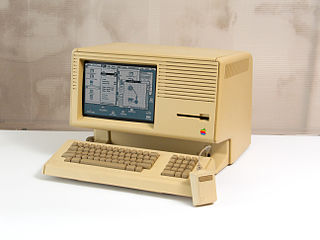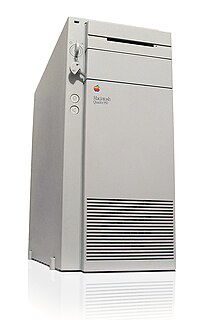
Lisa is a desktop computer developed by Apple, released on January 19, 1983. It is one of the first personal computers to present a graphical user interface (GUI) in a machine aimed at individual business users. Development of the Lisa began in 1978, and it underwent many changes during the development period before shipping at US$9,995 with a five-megabyte hard drive. Lisa was affected by its high price, insufficient software, unreliable Apple FileWare floppy disks, and the immediate release of the cheaper and faster Macintosh. Only 10,000 Lisas were sold in two years.

The Apple IIe Card is a hardware emulation board, also referred to as compatibility card, which allows compatible Macintosh computers to run software designed for the Apple II series of computers. Released in March 1991 for use with the LC family, Apple targeted the card at its widely dominated educational market to ease the transition from Apple II-based classrooms, with thousands of entrenched educational software titles, to Macintosh-based classrooms.

The Macintosh Plus computer is the third model in the Macintosh line, introduced on January 16, 1986, two years after the original Macintosh and a little more than a year after the Macintosh 512K, with a price tag of US$2,599. As an evolutionary improvement over the 512K, it shipped with 1 MB of RAM standard, expandable to 4 MB, and an external SCSI peripheral bus, among smaller improvements. Originally, the computer's case was the same beige color as the original Macintosh, Pantone 453; however, in 1987, the case color was changed to the long-lived, warm gray "Platinum" color. It is the earliest Macintosh model able to run System Software 5, System 6, and System 7.

The Zip drive is a removable floppy disk storage system that was introduced by Iomega in late 1994. Considered medium-to-high-capacity at the time of its release, Zip disks were originally launched with capacities of 100 MB, then 250 MB, and finally 750 MB.

SuperDrive is the name of an optical disk drive made and marketed by Apple Inc. The name was intially what Apple called their floppy disk drive, and later the internal CD and DVD drive integrated with Apple computers. Though Apple no longer manufactures computers that feature built-in SuperDrives, the name is still used when referring to Apple's external CD and DVD drive accessory (pictured).

The Macintosh SE is a personal computer designed, manufactured, and sold by Apple Computer, from March 1987 to October 1990. It marked a significant improvement on the Macintosh Plus design and was introduced by Apple at the same time as the Macintosh II.

The Macintosh 128K, originally released as the Apple Macintosh, is the original Apple Macintosh personal computer. Its beige case consisted of a 9 in (23 cm) CRT monitor and came with a keyboard and mouse. It played a pivotal role in establishing desktop publishing as a general office function. A handle built into the top of the case made it easier for the computer to be lifted and carried. It had an initial selling price of US$2,495. The Macintosh was introduced by the now-famous US$370,000 television commercial directed by Ridley Scott, "1984", which aired on CBS during the third quarter of Super Bowl XVIII on January 22, 1984. Sales of the Macintosh were strong from its initial release on January 24, 1984, and reached 70,000 units on May 3, 1984. Upon the release of its successor, the Macintosh 512K, it was rebranded as the Macintosh 128K. The computer's model number was M0001.

The Macintosh 512K is a personal computer that was designed, manufactured and sold by Apple Computer, inc. from September 1984 to April 1986. It is the first update to the original Macintosh 128K. It was virtually identical to the previous Macintosh, differing primarily in the amount of built-in random-access memory. The increased memory turned the Macintosh into a more business-capable computer and gained the ability to run more software. It is the earliest Macintosh model that can be used as an AppleShare server and, with a bridge Mac, communicate with modern devices.

Macintosh XL is a modified version of the Apple Lisa personal computer made by Apple Computer, Inc. In the Macintosh XL configuration, the computer shipped with MacWorks XL, a Lisa program that allowed 64 K Macintosh ROM emulation. An identical machine was previously sold as Lisa 2/10 with the Lisa OS only.
Macintosh File System (MFS) is a volume format created by Apple Computer for storing files on 400K floppy disks. MFS was introduced with the original Apple Macintosh computer in January 1984.
General Computer Corporation (GCC), later GCC Technologies, was an American printer company formed in 1981 by Doug Macrae, John Tylko, and Kevin Curran. The company began as a video game company and then later changed to make computer peripherals.

The ProFile was the first hard disk drive produced by Apple Computer, initially for use with the Apple III personal computer. The original model had a formatted capacity of 5 MB and connected to a special interface card that plugged into an Apple III slot. In 1983, Apple offered a ProFile interface card for the Apple II, with software support for Apple ProDOS and Apple Pascal.

The Macintosh Quadra 950 is a personal computer designed, manufactured and sold by Apple Computer, Inc. from March 1992 to October 1995. It replaced the Quadra 900 that was introduced several months earlier, increasing the CPU clock rate of its 68040 CPU from 25 MHz to 33 MHz, and improving the graphics support. The two computers were otherwise identical, including the price. With a Macintosh Processor Upgrade Card installed, this computer is known as the Power Macintosh 950.

The Snow White design language is an industrial design language which was developed by Hartmut Esslinger's Frog Design. Used by Apple Computer from 1984 to 1990, the scheme has vertical and horizontal stripes for decoration, ventilation, and to create the illusion that the computer enclosure is smaller than it actually is. The stripe element bears some similarity to earlier product designs at Atari, where Steve Jobs was a part-time technician from 1974-1975.

The Disk II Floppy Disk Subsystem, often rendered as Disk ][, is a 5+1⁄4-inch floppy disk drive designed by Steve Wozniak at the recommendation of Mike Markkula, and manufactured by Apple Computer, Inc. It went on sale in June 1978 at a retail price of US$495 for pre-order; it was later sold for $595 including the controller card and cable. The Disk II was designed specifically for use with the Apple II personal computer family to replace the slower cassette tape storage. These floppy drives cannot be used with any Macintosh without an Apple IIe Card as doing so will damage the drive or the controller.

The Macintosh Quadra 630 is a personal computer designed, manufactured and sold by Apple Computer, Inc. from July 1994 to October 1995. It was introduced as the replacement for the Quadra 610, and was the least-expensive computer in the Macintosh lineup with prices starting at $1,199 USD.

The Power Macintosh 5500 is a personal computer designed, manufactured, and sold by Apple Computer, Inc. from February 1997 to March 1998. Like the Power Macintosh 5260 and 5400 that preceded it, the 5500 is an "all-in-one" design, built around a PowerPC 603ev processor operating at 225, 250 or 275 megahertz (MHz).

The Macintosh Hard Disk 20 was the first hard drive developed by Apple Computer specifically for use with the Macintosh 512K. Introduced on September 17, 1985, it was part of Apple's long-awaited solution toward completing the Macintosh Office announced in January 1985. It would be over a year more before Apple would release the file server software AppleShare that would link all of the hardware together. By that time the SCSI interface introduced on the Macintosh Plus in January 1986, would accommodate far faster and more efficient hard drives, rendering the Hard Disk 20 virtually obsolete.

The Apple Hard Disk 20SC is Apple's first SCSI based hard drive for the Apple II family as well as the Macintosh and other third party computers using an industry standard SCSI interface.

The Macintosh External Disk Drive is the original model in a series of external 3+1⁄2-inch floppy disk drives manufactured and sold by Apple Computer exclusively for the Macintosh series of computers introduced in January 1984. Later, Apple would unify their external drives to work cross-platform between the Macintosh and Apple II product lines, dropping the name "Macintosh" from the drives. Though Apple had been producing external floppy disk drives prior to 1984, they were exclusively developed for the Apple II, III and Lisa computers using the industry standard 5+1⁄4-inch flexible disk format. The Macintosh external drives were the first to widely introduce Sony's new 3+1⁄2-inch rigid disk standard commercially and throughout their product line. Apple produced only one external 3+1⁄2-inch drive exclusively for use with the Apple II series called the Apple UniDisk 3.5.















